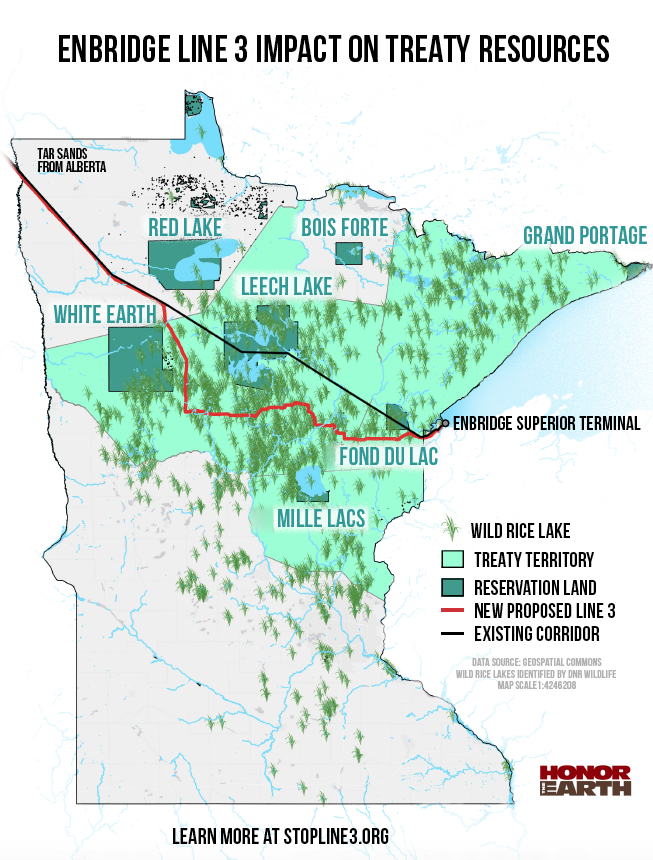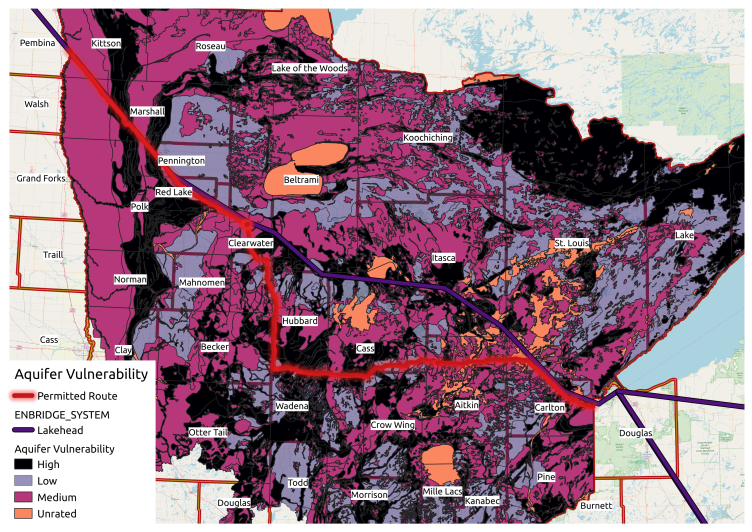by Scott Russell. This article originally appeared in Healing Minnesota Stories.
So why is the project still under consideration?
The proposed Enbridge Line 3 crude oil pipeline will run 340 miles through northern Minnesota, crossing more than 200 water bodies and 75 miles of wetlands. It also threatens wild rice areas important to the Anishinaabe.
Stunningly, Enbridge already has admitted to state regulators that pipeline construction won’t meet state environmental standards for protecting water. Adding to the problem, Enbridge hasn’t provided details about which environmental standards it plans to disregard or where. Instead, Enbridge has provided generalities which essentially boil down to: “Trust us.”
Sadly, the “Trust Us” argument appears to have traction among state regulators, another example of the power imbalance favoring industry in the state’s regulatory system. Notably, while the Minnesota Public Utilities Commission (PUC) in particular seemed to have ample trust in Enbridge, approving the project last year, it ignored Anishinaabe bands’ claims to treaty rights to hunt, fish, and gather on lands and waters threatened by Line 3.

Map shows current Line 3 and Enbridge’s initial
proposed route. The route has since had some
alterations. (Map courtesy of Honor the Earth)
Line 3 is currently in legal limbo, facing challenges in the Minnesota Court of Appeals. It if clears those hurdles, it still needs permits from other agencies such as the Minnesota Department of Natural Resources (DNR) and the Minnesota Pollution Control Agency (MPCA). Permit reviews were started, but are on hold now until legal issues get sorted out.
One of those permits is very revealing: Enbridge’s Application to Cross Public Waters, published in November 2018. On page 22, Enbridge says that it has “sought to minimize or avoid impacts” from pipeline construction.
… however, it is not feasible to adhere to all routing standards on a project of this scope and size, given northern Minnesota’s topography and environment (e.g., avoiding wetlands). Accordingly, Enbridge indicated on its application form that not all of the proposed PWI [public water inventory] crossings comply with the environmental standards as listed in Minnesota Rules 6135.1100.
Minnesota Rule 6135.1100 defines “Standards for Route Design” for utility land and water crossings. It says the pipeline route should “run along fringe of forests rather than through them” and it needs to avoid:
- steep slopes
- wetlands
- highly erodible soils
- areas with high water tables, especially if construction requires excavation.
- streams, but if that is not feasible and prudent, cross at the narrowest places wherever feasible and prudent, or at existing crossings of roads, bridges, or utilities
- lakes, but where there is no feasible and prudent alternative route, minimize the extent of encroachment by crossing under the water.
Based on Enbridge’s “Application to Cross Water Bodies,” the PUC should revoke Line 3’s Certificate of Need. State Rule 7853.0130 sets criteria the PUC needed to consider for the Certificate of Need. The last factor says the PUC should grant the Certificate — unless Line 3’s construction “will fail to comply” with state and federal rules and policies. By Enbridge’s own admission, it won’t be comply with state rules.
Comment: Regulators have two options in responding to Enbridge’s admission that it can’t meet state environmental rules. Option One: Acknowledge northern Minnesota’s “topography and environment” make it the wrong place for a crude oil pipeline. Option Two: Ignore the rule book. So far, Option Two seems to have the edge.

Aquifer Vulnerability Map along Line 3,
courtesy of Honor the Earth.
A shroud of secrecy
Honor the Earth, Friends of the Headwaters and the Sierra Club filed comments with the DNR May 17 expressing concern about the secrecy surrounding communications between the DNR and the lack of details in Enbridge’s “Application to Cross Public Waters.” The letter says:
… it appears the DNR has conducted extensive discussions with Enbridge related to the contents and scope of the various applications filed by Enbridge, … but the DNR has failed to provide any of that information exchanged between Enbridge and the DNR to the public … Withholding all information about the years of discussions between the DNR and Enbridge indisputably puts citizens at a disadvantage …
The letter sought the release of numerous documents. Two months later, still no response from the DNR.
The letter also criticized Enbridge’s application for its lack of detail:
They [Enbridge] discuss water and land crossings almost entirely in general terms but fail to provide the DNR with details needed to make judgments that Enbridge’s proposed crossings, “provide maximum protection and preservation of the natural environment …”
Enbridge’s approach to its Application is generally to assert that it intends to do the best job it can to minimize impacts without discussing the situation at each crossing. … Absent such site-specific information, the DNR does not have sufficient information to justify Enbridge’s proposed [rule violations].
Comment: Where is Gov. Tim Walz? The secrecy and arbitrary rule enforcement around Line 3 erode public trust in government and highlight industry’s behind-the-scenes influence. Concerns by watchdog groups about private communications between Enbridge and the DNR are only amplified by recent revelations that the MPCA suppressed damaging information about the PolyMet Mine proposal. What are the DNR and Enbridge hiding?
We need to enforce state rules protecting water. We need more transparency about state government’s dealings with industry.
Thanks to Paul and Nicolette for providing key information for this blog.